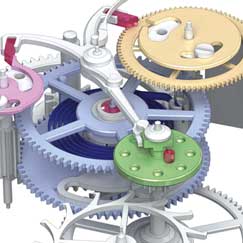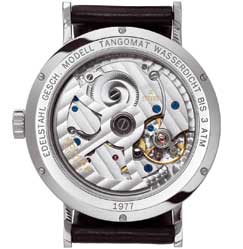Moving with the times
The town of Glashütte in Eastern Germany is widely regarded as the birthplace of German watchmaking, home to the country’s premiere wristwatch horologists.
As one of the key names from the town, tradition plays an important part in what is designed and built by A Lange & Söhne. With a history stretching back to 1845, the company is renowned for its timepieces the world over.

The Lange Zeitwerke combines the principles of a mechanical wristwatch with an eloquent jumping numeral display

“In fine watchmaking, progress is always a result of curiosity,” states Lutz Grossmann, head of the movement design department. “At Lange, the development of a new calibre usually starts with a watchmaker’s question: “How can the principles of a mechanical watch and a modern time indication format persuasively be combined?”

“The answer is the first mechanical wristwatch with a truly eloquent jumping numeral display. With the Lange Zeitwerk we wanted to define a new direction in mechanical watchmaking by creating a watch that lets its owner experience a new sense of time.”
A significant amount of energy is required to simultaneously advance all three numeral discs once every hour, and is delivered by a newly developed barrel with an extra-strong mainspring. This features a constant-force escapement between the barrel wheel and the balance acts as a pacemaker for the jumping advancement of the hours and minutes. “In its compactness, the mechanism is quite likely unprecedented,” exclaims Lutz.
The first prototype is built as a 3D CAD model in Solid Edge. “Each piece is designed by entering all the relevant measurements – often after having drawn the piece on a sheet of paper and having done various calculations. For some parts of the movement we have also created prototypes during this development process to test its function,” explains Lutz, adding that to a minor extent his team uses Finite Element Modelling (FEM), for example, for the improvement of springs, comparing them to the built prototypes to correct springs if necessary.
“Today’s systems don’t allow absolute calculations because of the tininess of our watch components,” reveals Lutz, adding: “but we are curious about the further developments.”
It is likely that in the future this traditional industry will build on its use of design technology, as it continues to move with the times.
All in the wrist

This Nomos Glashütte Tangomat watch may be the epitome of simple, elegant design, but there’s a lot going on beneath the surface to make it run smoothly.
The Tangomat is based on a classic model from the German timepiece manufacturer, based in Glashütte, Saxony. Developed over two years as a result of customer requests, it contains a movement that winds itself automatically whenever its wearer moves their arm.
Its design team takes great pride in the aesthetical beauty of its work but also spends a great deal of time developing its own parts and movements to achieve the highest level of accuracy and function.
Initial drafts are made according to basic calculations and a 2D-front view that encompasses all the additional features that the wristwatch will include.

“Now, designers and constructors can work side by side,” explains watchmaker Mirko Heyne. “The construction is set up in 3D. Taking into consideration what methods of manufacturing are at hand, and what methods have a reasonable price. We then design the individual parts. Already during the developmental process, we divide the movement into assemblies to allow for an efficient mounting.
“For construction purposes, we use Solid Edge. This software is employed to create all data for the movements and all drafts. The 2D first drafts, 3D constructions, and 2D sketches of the individual parts are all implemented with the help of this software,” continues Mirko.
When testing parts, theoretical values are calculated in advance through the design process but have to be verified by practical experience. “What we simulate, however, is the assembly process in order to allow for an efficient work process later on,” states Mirko, adding that this helps with the difficult task of predicting a date for the product’s series-production readiness.
Building all its own components requires high quality craftsmanship. This even relates to prototypes for which Nomos uses high precision nano-fabrication x-ray LIGA-technology to build models with properties similar to the final material.
Helpfully, to appreciate all this technology, the Tangomat has a glass back for the wearer to view the Glashütte art of watchmaking in all its glory.
It’s disco time
When it comes to watchmaking, there is no more famous a land than Switzerland, a postcard picture of wooden huts in the snowy mountains with craftsmen delicately working away on wheels and cogs.

While traditional skills are still very much at the heart of the industry, new designs are benefitting from 3D CAD to save time and realise working prototypes before a single physical part is built or assembled.
Paul Picot is a highly regarded watchmaker from the the town of Le Noirmont. Chef de projet, Pascal Franck Kunz, works to produce limited collections of designs, built from precious metals. The latest project is the Technograph Discotime a stainless steel watch that features coloured disks instead of a second hand and a chronograph minute counter, to bring life to the dial.
“The movement had to be tested to see how it would react to the use of disks, compared to normal hands. The force and power ratios are very different!”
After the 3D development process a physical prototype was built as there are still often slight differences between simulation and practice, however virtual prototyping is a cost and time efficient way of testing wristwatch concepts.
“The achievement of our projects is the result of the combination of our people, know-how, expertise and creativity and all the technology,” concludes Pascal, acknowledging that software such as Solidworks is allowing his team to test new concepts and materials such as slate and carbon for future luxury timepieces.






